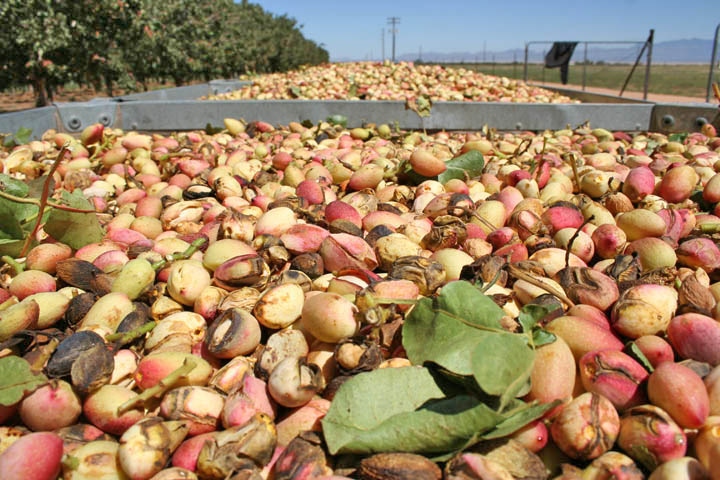February 4, 2014

The D word – drought – slipped into more than a few presentations at this year’s Statewide Pistachio Day and also spilled into conversations among exhibitors outside the room where more than 500 gathered in Visalia.
It came up during a discussion of what a researcher called California’s worst navel orange worm infestation ever last year.
It was first broached by the event’s opening speaker, Tulare County Board of Supervisors Chairman Phil Cox, who welcomed participants and told them the county will stop watering parks, lawns and planters because of the drought.
“We’re going to do our part to save as much water as we can (and) give you, the farmers, the water you need to grow your crops,” Cox said.
One presenter said lower weed growth as a result of the drought may actually be beneficial at keeping some pest populations down. But some of those pests may move into the orchards from the foothills sooner this year, he warned.
Richard Matoian, executive director of the American Pistachio Growers based in Fresno, said the lack of water “will throw out conventional thinking” in the industry and will make estimating the size of the crop “nearly impossible.”
“Less water will probably mean smaller nuts,” he said, adding that growers will have to grapple with issues that include water delivery, water quality and financing. Pistachios do require less water than almonds, he conceded, “but we need water.”
Bob Klein, manager of the California Pistachio Research Board, said the drought has brought more dust and stagnant air, further heightening the concerns over regulation of air quality and levels of particulate matter in the range of 10 and 2.5 microns.
“We can expect surcharges on fuel and diesel engine regulations,” Klein said.
Klein urged growers to join coalitions that have formed to deal with regulations imposed by the Central Valley Regional Water Quality Control Board. “Keep your eyes on the East San Joaquin Water Quality Coalition,” he said, adding that growers should work on “nitrogen budgets” to address a problem of nitrates in drinking water and “to keep water in the root zone.”
Perhaps the darkest outlook for the industry came in a presentation by Joel Siegel with the U.S. Department of Agriculture’s Agricultural Research Service in Parlier. At last year’s conference, he referred to 2012 as a “blowup year” for navel orange worm despite a record high crop exceeding 555 million pounds.
Last year was even worse, he said. “This (2013) was the worst year ever,” Siegel said.
Infestation jump
He said the jump in infestation was the result of “high heat and a high overwintering population.” Siegel said the pest can weather extreme cold with temperatures as low as 16 degrees, but “some mortality is associated with cold weather and rain that can occur December into February, and we haven’t really had either.”
Among those hard hit in 2013 by the NOW pest was Fresno County, with a level of 1.52 percent of insect damage, the first year the damage had exceeded 1 percent; Kern County at 1.79 percent; Kings County at 2.37 percent and Tulare County at 2.11 percent, only down slightly from 2012’s 2.18 percent.
“The trend is going the wrong way in these drought, high heat years,” Siegel said. “Everybody is making money, but quality is being eroded.”
To combat the trend, he said, growers need to increase sanitation, prevent splits with irrigation management, increase sprays, improve coverage and harvest early and double shake as needed.
Siegel fears the problem could be exacerbated as new plantings come into bearing in the next four years “and we go from islands (of pistachio orchards) to a monoculture.”
“Now is the time to think of insecticides and plan ahead to apply sprays at 2 miles per hour max and at 150 gallons per acre minimum,” he said.
He closed with a quote from Dan Quayle: “The future will be better tomorrow.”
David Haviland, University of California entomology farm adviser with Kern County, took a rare stab at predicting the future for infestation of some pests.
He said infestations from small bugs – such as lygus, calocoris, phytocoris and California buckeye bug – will likely be smaller this year because of a decline in weed growth due to the drought. But those pests may move into pistachio orchards from the foothills earlier, Haviland said.
He believes stink bugs will be a “non-issue” due to use of pyrethroids. As for leaffooted bugs, he said, populations were high but they were hurt by a freeze in December.
For mealybugs, he said, it will be a “normal” year.
Monitoring for all pests and timing sprays properly is a key to insect management, Haviland said. He emphasized a need to be able to distinguish among the different insects and recognize that some can be beneficial. For example, the phytocoris preys on NOW eggs. And the rough shouldered stink bug is a predator that feeds on insects.
To combat the gilli mealybug, he said, growers can use sprays in June against crawlers; prevent spread by washing harvest equipment and monitor at harvest to prevent newly infested fields.
Themis Michailides, plant pathologist with UC Davis, talked of steps growers can take to address Altenaria late blight that include managing irrigation, improving water infiltration, hedging trees to increase orchard ventilation and not using cover crops.
He said several fungicides are registered for use against the disease.
There are also several fungicides that can be used against Botryosphaeria, he said, terming the disease “a sleeping giant” because it can accumulate in older trees and then be “awakened.”
More from Western Farm Press
Top 10 agricultural law developments of 2013
Organic rant from unhappy reader; musings from corporate-funded editor
Big Ag goes organic (Come again?)
About the Author(s)
You May Also Like




